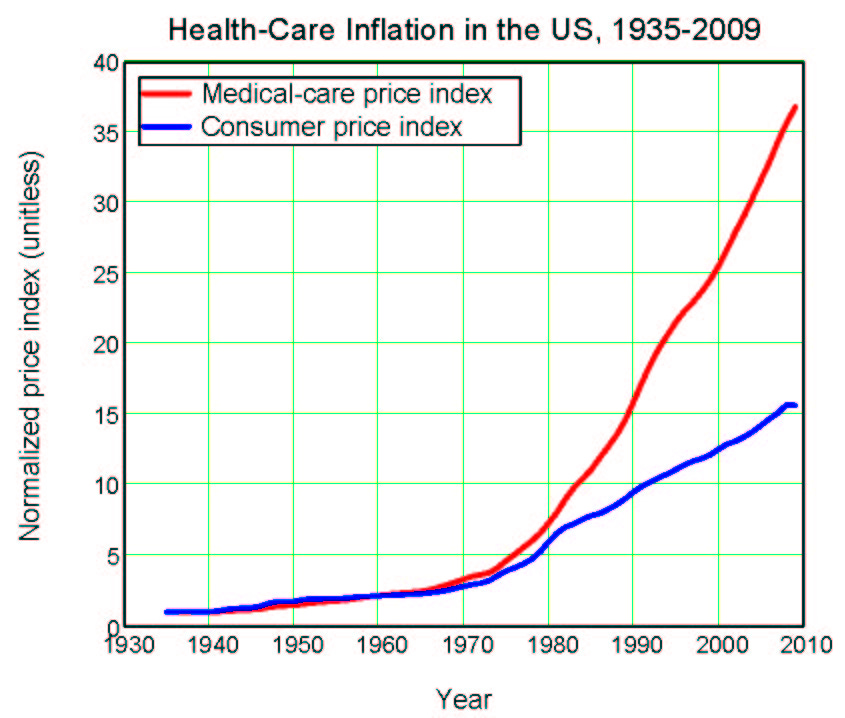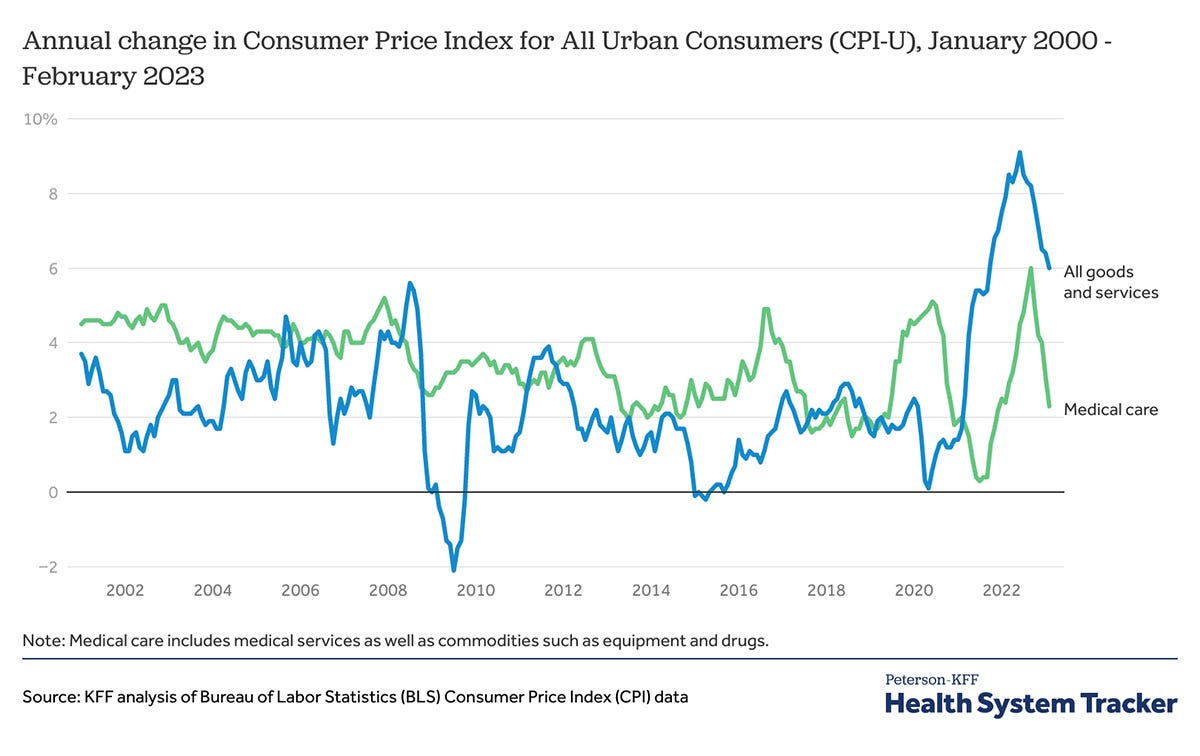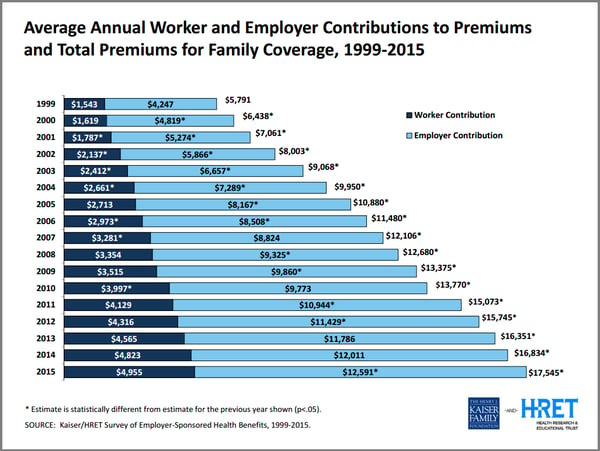Employer health insurance plans should be voluntary
and employees should be able to keep the cash value in their salaries.
A key goal of my From Poverty to Progress book series and this Substack column is to argue that the main goals of government policy should be to:
Promote a clear pathway that enables youths from low-income families to enter the prosperous working class.
In this article, I will focus on the second goal. What the American working class needs more than anything is affordable prices. The cost of medical care in the United States has been anything but affordable. For the last 60 years, inflation within the medical sector has been substantially greater than almost all other products or services.
This is in contrast to the prior 30 years. From 1935 to 1965, the annual health-care inflation rate averaged 3.06%, while the average annual increase in the CPI was 2.81%. This amounts to a total of only 8.8% difference in price increases. After 1965 annual health-care inflation was 42.1 higher than the CPI.
And this trend continues to today with an apparent deviation immediately after the covid lockdowns.
A major contributing factor to this excessive inflation is how we pay for our medical care. Most Americans are forced to pay for expensive employer health insurance whether they want it or not.
Most Americans receive health insurance from their employers. Most Americans consider this a “benefit”, but they have no effective choice. The employer typically chooses one or more plans offered by a private insurance company. The employee then chooses between the plans being covered by their employer. The employer and the employee then split the cost of the insurance with the employer typically paying far more than the employee.
For the last 60 years, employer-provided health insurance has swallowed up a higher percentage of workers’ total compensation packages.
One of the biggest misnomers in employee compensation is calling employer health insurance plans a “benefit.” This makes it sound as if an employee is getting something in addition to his/her salary. In reality, employers require their employees to accept the health insurance plan of their choosing instead of a portion of their salary.
See more articles on Upward Mobility:
Why Progress and Upward Mobility should be the goal, not Equality
The Pathway to Success (first article in three-part series)
I also will be writing a significant number of excerpts from my forthcoming book: Upward Mobility: A Radical New Agenda to Uplift the Poor and Working Class. Most of these excerpts will only be available to paid subscribers.
Other books in my “From Poverty to Progress” book series:
According to the Kaiser Family Foundation survey, in 2019 the average premium for a family insurance plan was $20,876 with the employer paying for just over 70% of the total cost. Since the median household income in 2019 was $65,712, this means that roughly 24% of that family’s total compensation is diverted toward health care. For low-income workers who have employer-provided health insurance, the percentage is substantially higher.
While Obama’s health care reform was sold as a means of lowering the cost of health care, the result has been the opposite. The average premium has increased by 53.8% since 2009, far higher than either the core rate of inflation or increases in workers’ income.
Health insurance is also a very substantial portion of government spending. In 2019 the federal government spent nearly $1.2 trillion on health care. The biggest chunks were:
Medicare at $644 billion
$427 billion for Medicaid and CHIP
Veterans’ medical care costs another $80 billion
State and local governments spent about $300 billion on health care.
In addition to direct spending, the federal government “spent” $234 billion on tax expenditures related to health care. By far the largest cost was the exclusion of employer contributions for medical insurance premiums ($152 billion). If you add up all the costs of direct and indirect spending for all levels of government, it comes to a stunning $1.7 trillion per year. And the amount increases virtually every year.
The reason for all of this healthcare inflation is simple:
Third parties pay the costs of treatment (rather than consumers paying the cost directly), and
Prices are not transparent.
There is little to no overseas competition.
Some people claim that this inflation is an inevitable characteristic of medical care. Medical treatments that are not covered by government subsidies or health insurance, however, show that this is not the case. Prices for medical treatments that are paid exclusively by cash have not seen excessive inflation.
Cosmetic surgery is rarely covered by insurance, so the entire industry must operate on the traditional market model. Because patients pay the entire cost in cash, they factor price into their decisions. Cosmetic surgeons know this, so they work hard to keep their costs competitive.
Between 1998 and 2019, the average cost of cosmetic surgery increased by 35.0%, far less than the overall rate of inflation (56.8%). This means that cosmetic surgery is getting cheaper every year compared to the cost of other goods.
More importantly, the increase in the cost of cosmetic surgery was a small fraction of the rate of inflation for medical care services (117%) and hospital services (208%). If all medical services had a below-average rate of inflation, affordable medical care would quickly become a reality.
Given that cosmetic surgery is a luxury good with a very affluent customer base, one would that plastic surgeons actually have less incentive to keep costs down than doctors in other fields. If our entire medical industry were also on a cash-only basis, how much money might be saved?
We need to fundamentally transform how Americans pay for medical care. Expanding private insurance has not cut costs. Expanding government coverage has not cut costs. Rather than dousing the fires of healthcare inflation, they have dropped napalm on it. Almost every previous attempt to contain costs has accelerated the increase in cost. The result has been distinctively unaffordable medical care.
This Substack column is not about health care. I have no intentions of redesigning the entire healthcare system to make the system optimal. I have taught several university-level courses on Health Care Policy, so I know how extraordinarily complicated the system is
This Substack column is about promoting upward mobility for the working class and the poor. Since medical care takes up such a large and ever-increasing portion of the total compensation package of the working class, however, the topic must be addressed. This series of articles will only skim the surface, but I will focus on reforms that will make medical care more affordable for the working class and poor.
A new healthcare system should be based on the following principles:
Transparent prices
Transparent reporting of results
Cash payments by individuals
Catastrophic health insurance
Making employer-paid health insurance optional
Opening up surgical procedures to foreign competition
Opening up medical diagnoses and treatment to nurses
This is such a drastic change from our current model of third-party payment that it needs to be done in stages. We need to gradually introduce prices and cash payments so that providers can innovate new business models that deliver affordable care.
Catastrophic Medical Insurance
A key part of making medical care affordable must be Catastrophic Medical Insurance. While most medical insurance plans are designed to pay for the bulk of medical-related purchases, Catastrophic Medical Insurance only pays for extremely expensive care that impacts most people only a few times in their lives.
Catastrophic Medical Insurance has a very high annual deductible. Persons with this type of coverage pay for the vast majority of their care with cash. Once the person reaches the annual deductible, however, the remainder is paid for by insurance.
At one time Catastrophic Medical Insurance was widely available. I have had this type of insurance in the past, and I found it perfect for my situation.
The primary benefit of Catastrophic Medical Insurance is that the premiums are dramatically lower than a more traditional plan. Rather than thousands of dollars per month, it is typically a few hundred dollars per month. At these prices, even the poor can afford to pay for it.
Unfortunately, many politicians and political activists deem Catastrophic Medical Insurance to be “under-insurance.” Congress and state legislatures have gradually added on more and more types of treatments that must be covered by insurance that have effectively made Catastrophic Medical Insurance illegal.
Keep reading with a 7-day free trial
Subscribe to From Poverty to Progress to keep reading this post and get 7 days of free access to the full post archives.













